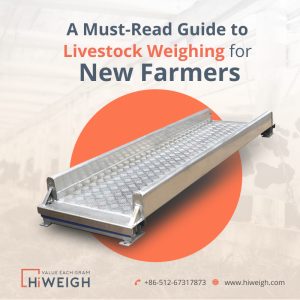


As the agricultural industry evolves, young farmers face a plethora of skills they must learn in order to assure the success of their operations. Weighing animals is one of these key abilities. Accurate weighing not only aids in the monitoring of animal health and growth, but it also plays an important part in efficient farm management and profitability. That’s why we are going to discuss the procedures to educate novice farmers on livestock weighing abilities, assisting them in becoming skilled in this crucial component of farming.
The Importance of Livestock Weighing
Before delving into the practical elements of teaching livestock weighing, new farmers must understand the relevance of this ability. Weighing livestock has various advantages:
Health Monitoring
Weighing animals on a regular basis can help detect early symptoms of disease or weight loss, allowing for appropriate intervention.
Feed Efficiency
It allows farmers to change feeding schedules based on an animal’s weight, decreasing waste and increasing efficiency.
Market Readiness
When selling cattle, accurate weights are critical for ensuring fair pricing and profitability.
Data-Driven Decision-Making
Weighing livestock gives significant information that may be used to make educated decisions regarding breeding, culling, and herd management.
Choosing the Best Equipment
Choosing the proper equipment is the first step in teaching livestock weighing. There are several types of livestock weighing scales on the market, including digital and mechanical scales. The decision is influenced by factors such as herd size, budget limits, and existing infrastructure. For accurate results, ensure that the chosen scale is correctly calibrated and maintained.
Priority is given to safety.
Prior to getting started with weighing, prioritize safety. New farmers should be aware of the dangers connected with managing animals and equipment. Ascertain that they are aware of correct safety measures and that they have the essential protective equipment, such as gloves and boots.
Fundamental Weighing Techniques
Even though a livestock scale manufacturer provides a manual with a weighing scale, it is critical to teach young farmers the fundamentals of livestock weighing. Here’s a step-by-step procedure:
Step 1: Get the Animal Ready
- Ascertain if the animal is quiet and relaxed.
- Lead the animal into a dedicated weighing area or chute, if feasible.
- Overcrowding can cause stress in animals.
Step 2: Making Use of the Scale
- Instruct them on how to lead or assist the animal onto the scale platform, depending on the type of scale.
- To get an exact weight, make sure the animal is standing motionless and balanced on all four legs.
- Take note of the weight indicated on the scale.
Step 3: Data Documentation
- Stress the need for maintaining correct records.
- Keep a record of each animal’s weight, date, and any pertinent remarks (for example, health observations).
- Encourage the use of digital tools or applications to make data management easier.
Step 4: Data Analysis
- Teach young farmers how to analyze weight data collected.
- Explain the relevance of data trends and patterns for decision-making.
Practical Experience
For novice farmers to build confidence in livestock weighing, hands-on instruction is essential. Organize practice sessions where novices can weigh animals while being watched. Give advice on suitable procedures and constructive critiques.
Troubleshooting Common Problems
Prepare novice farmers for frequent livestock weighing issues, such as animals refusing to walk onto the scale or becoming upset. Teach students how to handle these circumstances in a safe and efficient manner.
Advanced Methods
Once novice farmers have mastered the fundamentals, promote more complex approaches such as:
- Efficiently weighing groups of animals
- Using digital technologies to gather and analyze data automatically
- Implementing electronic identification (EID) systems for tracking individual animals
Ongoing Learning and Development
Encourage novice farmers to not only depend on the manuals provided by a livestock scale manufacturer but to always improve their livestock weighing abilities. Attend cattle management and weighing workshops, conferences, or online training. Keeping up with the newest technology and best practices can lead to improved agricultural results.
Collaboration and Networking
Highlight the importance of networking within the farming community. Encourage novice farmers to network with experienced farmers and to become members of local agricultural organizations. Collaboration with others provides useful ideas and assistance with livestock weighing and agriculture.
Final Thoughts
Teaching novice farmers how to weigh cattle is an important aspect of their agricultural education. New farmers can develop the expertise needed to manage their livestock effectively by understanding the importance of accurate weighing, selecting the right equipment, prioritizing safety, and providing hands-on training. They will not only improve the well-being of their animals as they gain expertise in this crucial skill, but they will also contribute to the overall prosperity and sustainability of their farms.
